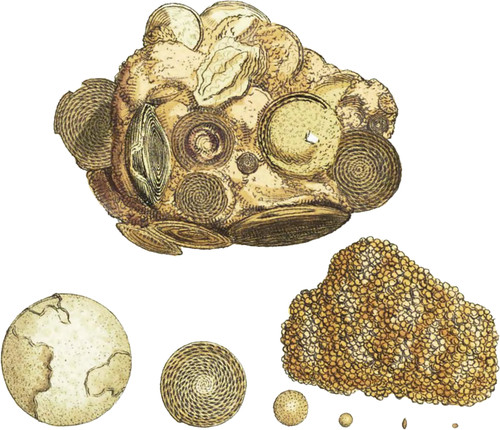 Enlarge
Enlarge
British Mineralogy
Shell-formed Carbonate of Lime
- Div. 2. Imitative.
Our travellers, Mr. Cripps and Dr. Clarke of Cambridge, found that the Limestone at the foot of the Pyramids of Egypt, at Djiza, was of a peculiar structure, and that Strabo had described it as composed of lentils (which were the food of the workmen employed in these vast structures) become petrified. This helps us towards the knowledge the ancients had of these things. Pallas, as Dr. Clarke observes, took them for fishes’ bones, and indeed they have some resemblance to the plates between the vertebræ of the Porpesse; but in the present day they are determined to be the petrified remains of Nautili, of the species called Nummulariæ from their resemblance to flat pieces of money. Their readily splitting, or being found in halves, might give rise to the ludicrous idea of their having been the pea-like food of the workmen at the Pyramids; and their having no apparent avenue answerable to the opening of a shell, with the minuteness of the chambers looking like pores in bones, &c. might be the cause of the latter opinion.
Thus much we have learned, which gives significance to the present subject, and I am of opinion properly so; and by the trouble and expense of travelling, we shall learn the value of curiosities at home. Independent of this, the formation is now perhaps first made known as belonging to our own country.
The upper specimen is from Bracklesham Bay in Sussex, and is similar, in regard to the substance, to common Limestone. I have some specimens separate, and some in a greenish sandy mixture. The aggregate right hand specimen is from Kettering, and has, I believe, always been considered as the flatter variety of that stone commonly called Roestone. See tab. 8. The specimen before us, however small, shows the chambered structure of the Nautili of Linnæus with the help of a magnifying-glass; and among my specimens from these different places, I am enabled to show them of the sizes as in the plate. Their volutions are so numerous that they are not easily distinguished from concentric circles, especially in the smaller ones; and they fold over each other so closely, to the very centre, that no umbilicus is apparent; and we are not able to discover the vestige of an opening: nor have I seen the Siphunculus ; which is less a wonder, as those of the larger species are often very small; but comparison with specimens of recent species proves them to belong to the same genus: and it is peculiarly remarkable that we have of this genus only minute recent shells remaining in the sea-shore sand, as a proof of such living beings. It however appears that they may be found petrified in Great Britain, from the size of the smallest in these specimens to two or three feet in diameter, which would include an animal of nine or twelve feet long. I have them of these dimensions, and have been told of them much bigger, while we know of no recent ones above half an inch in diameter.
The figure and description of these as mineralogical subjects are the more instructive, as externally they much resemble the lenticular Carbonate of Lime, or Magnesian mixtures including those called White Iron Ores. I hare curious specimens from Gerona in Spain, by favour of—Danby, esq., which are less flat, but the parts are not more distinct; also one found in the Crimea. very flat.

